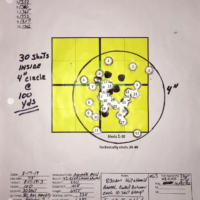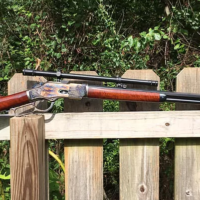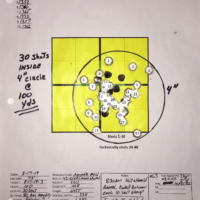I posted a longer post but for what ever reason it didnt work.
1873-1877 – In Winchester’s 1875 catalog the first 44 WCF cartridges appeared but were not labeled as “44 W.C.F”. Winchester stated, “The effect of this change [from 44 Henry to the 44-40] is to increase the initial velocity of the arm from about 1,125 f.p.s. to 1,325 feet per second.” During the Indian Wars, the Indians would proved how valuable the Lever-actions would become!! The Winchester black powder cartridge boxes had green labels.
The 44-40 started off life as the 44/100 but soon changed to 44 W.C.F. (Winchester Center Fire). By 1894, UMC (Union Metalic Cartridge Company) added the -40 designation for Marlin. By 1900, all manufactures called it the 44-40.
During the smokeless powder craze, by 1930 the 44-40 was loaded up to 2,000fps, used in the stronger action rifles, that produced 33,000cup. More modist factory loads by Winchester produced 1,600fps and produced 22,000cup. These were Winchester’s “High Velocity” loads. The Winchester Smokeless powder cartridge boxes had Red labels. Winchester’s High Velocity load boxes had Yellow labels.
Properly loaded handloads can result in 4″ groups at 100 yards in weak action rifles and can hit golf balls at 265 yards in the stronger action rifles.
“Lost” information from the 1800’s and early 1900’s has resurfaced with the advent of the “Information Highway” and have proved that the 44-40 as we now it today is soooo under rated.
Before handloading for this great cartridge, the hand loader must understand several things.
First;
1. Understand that a true 44-40 bullet has a diameter of .4255 – .427
2. Understand that older original pre-1900 rifles had bores as small as .424 and should not use bullets with diameters greater than .427…especially with loads that produce higher than modern SAAMI max pressures of 13,000cup/11,000psi (2015 SAAMI Standards)
3. Understand that most modern 44-40 firearms use 44 special/44 Magnum barrels with larger .429/.430 bores acceptable for using 44 Special and Magnum bullets with diameters of .429/.430 but “could” retain the smaller 44-40 case mouth dimensions making chambering difficult for thicker Remington brass using .429+ diameter bullets.
4. Understand what a true 44-40 bullet “Profile” looks like. Certain so called 44-40 bullets and/or the use of some 44 Special and 44 Magnum profile bullets may be “too wide” just forward of the case mouth and touch the driving bands of the bore when chambered. This, along with simply adjusting the AOL, can increase chamber pressures and could cause problems in older “weaker” firearms.
Second;
1. Understand the difference between “Group I and Group II” rifles mentioned in Lyman’s 49th handloading manual
2. Understand that the “thin” cylinder chamber walls in a revolver are certainly weaker than the thicker rifle barrel chambers and weaker than the “Action” on a Winchester 73′
Attachments:

8_17_19_2AND3_MEASURED.png


